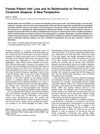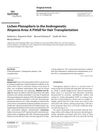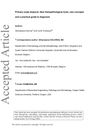TLDR The study found that treatment improved hair condition in patients with Fibrosing Alopecia in a Pattern Distribution in Chile.
The document reports on a clinical study of Fibrosing Alopecia in a Pattern Distribution (FAPD), a condition characterized by clinical and histopathological signs of both lichen planopilaris and androgenetic alopecia, in a Latin American population, specifically Chilean patients. The study, conducted between 2012 and 2016, included 13 diagnosed cases of FAPD out of 2018 patients with hair disease, representing 0.64% of the cases. The affected group comprised 9 women with an average age of 47.8 years and 4 men with an average age of 37 years. All patients were treated with clobetasol 0.05% shampoo and most also received minoxidil lotion, with some women requiring additional systemic medication such as finasteride and hydroxychloroquine. After one year of treatment, all patients showed clinical improvement, with 9 having mild improvement and 4 showing satisfactory response including signs of hair regrowth. This study is the first to describe FAPD in a Latin American population and suggests that larger multicenter studies are needed to further understand the condition and establish treatment guidelines.
 16 citations
,
February 2010 in “Journal of the European Academy of Dermatology and Venereology”
16 citations
,
February 2010 in “Journal of the European Academy of Dermatology and Venereology” Fibrosing alopecia in a pattern distribution is a unique hair loss condition that may respond to antiandrogen therapy.
 73 citations
,
November 2005 in “Journal of Investigative Dermatology Symposium Proceedings”
73 citations
,
November 2005 in “Journal of Investigative Dermatology Symposium Proceedings” Some women with common hair loss may develop permanent hair loss.
9 citations
,
November 2004 in “SKINmed Dermatology for the Clinician” A man with hair loss developed a condition causing scarring and inflammation in both bald and non-bald areas of his scalp.
 158 citations
,
February 2000 in “Archives of dermatology”
158 citations
,
February 2000 in “Archives of dermatology” Some people with pattern hair loss may also have scalp inflammation and scarring similar to lichen planopilaris.
 30 citations
,
January 2020 in “Journal of The American Academy of Dermatology”
30 citations
,
January 2020 in “Journal of The American Academy of Dermatology” Fibrosing alopecia in a pattern distribution is a hair loss condition often confused with other types, requiring early treatment but usually not resulting in significant hair regrowth.
 14 citations
,
January 2015 in “Skin appendage disorders”
14 citations
,
January 2015 in “Skin appendage disorders” Misdiagnosis of LPP in AGA patients can cause hair transplant issues.
 14 citations
,
September 2016 in “Journal of Cutaneous Pathology”
14 citations
,
September 2016 in “Journal of Cutaneous Pathology” The document concludes that new methods improve the accuracy of diagnosing scalp alopecia and challenges the old way of classifying it.
 158 citations
,
February 2000 in “Archives of dermatology”
158 citations
,
February 2000 in “Archives of dermatology” Some people with pattern hair loss may also have scalp inflammation and scarring similar to lichen planopilaris.
February 2025 in “Archives of Dermatological Research” Fibrosing alopecia can be diagnosed without typical signs of lichen planopilaris.
 16 citations
,
February 2010 in “Journal of the European Academy of Dermatology and Venereology”
16 citations
,
February 2010 in “Journal of the European Academy of Dermatology and Venereology” Fibrosing alopecia in a pattern distribution is a unique hair loss condition that may respond to antiandrogen therapy.







